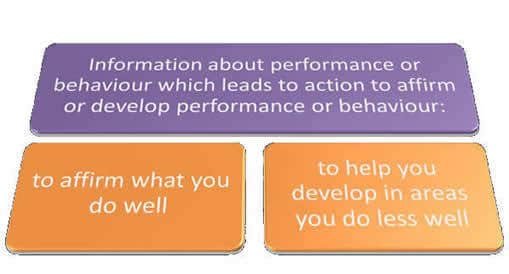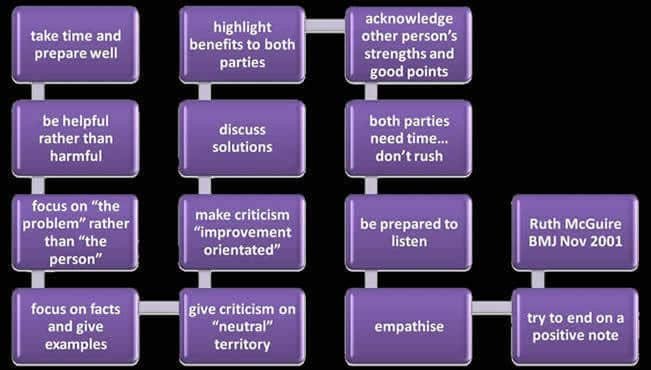Bradford VTS Online Resources:
Teaching & Learning
Feedback
DOWNLOADS
path: FEEDBACK
- teach-feedback
- effective and ineffective feedback.pdf
- feedback – everything you ever wanted to know.doc
- feedback – giving feedback to learners.pdf
- feedback – methods of parroting.pdf
- feedback – principles and examples.pdf
- feedback – theory and practise by king.doc
- feedback for GPs in training – a literature review.pdf
- feedback handout for gp trainees.doc
- feedback models.pdf
- feedback on 2 sides of A4.doc
- feedback on one side of A4.doc
- feedback via abcde.doc
- gibbs reflective cycle.doc
- gibbs strategies for supportive feedback.pdf
- giving and receiving feedback (with slide notes).ppt
- giving developmental feedback.ppt
- giving feedback – a quick snippet.doc
- giving feedback – how to.doc
- how to give and receive feedback effectively.pdf
- improving feedback and refllection – a practical guide.pdf
- pendletons rules for feedback on one side of a4.doc
- pendletons rules for giving feedback.doc
- pendletons rules for video feedback and critque of.doc
- set-go method of feedback.doc
- the art of giving feedback (with slide notes).pptx
- the art of giving feedback – brown and leigh.doc
WEBLINKS (for teachers)
- BVTS videos on giving feedback
- An activity – feedback practice (excellent)
- GP Training – giving effective feedback by a GP mentor
- Mindtools on giving feedback
- CEDAR model of giving collaborative feedback
- Giving & receiving feedback by skillsyouneed.com Giving & Receiving Feedback – Do’s and Don’ts
- ALOBA – video feedback (BVTS)
- Feeding back on the GP consultation (BVTS)
WEBLINKS (for learners)
Videos
Making praise really work
two
three
four
Making feedback more positive (PIPS)
What is feedback & what's the point?
Feedback is about providing information about performance or behaviour with the aim of affirming and/or developing performance or behaviour, i.e.
- to affirm what they do well
- to help them develop in areas they do less well (either qualitatively or quantitatively)
The whole point of giving this information is to help the receiver(s) do better the next time round. Without feedback, there is only self-reflection; self-reflection amounts only to teaching oneself.

Feedback is not...
Feedback is NOT:
About blame, approval or disapproval; evaluation is all about placing a value on a performance or piece of work. Feedback is less emotional – it merely describes what you did or did not accomplish given a standard or intent.
When giving feedback, beware of
- placing a negative emphasis on things too much. It is a mistake to concentrate exclusively on a person’s weaknesses. Feedback also reveals areas of strengths about which the participant should be encouraged to feel proud and to develop further. It should be balanced.
- just giving feedback without action, suggestions or support. For feedback to be useful it must result in action. A good facilitator can help the learner see the priorities,work through an action plan and offer suggestions.
Feedback for Learners
What type of feedback might I get?
For learners: feedback on your performance comes in many ways and is much more than the mark, grade or comments associated with assignments and exams. Using the feedback you are given is an essential part of your learning process and you should use it to help you progress. Look on feedback as being constructive, even if it appears critical of your performance. The following are ways in which you might get feedback…
- Written or verbal individualised feedback — for example, on a particular assignment, how well you consulted and so on.
- Written structured feedback based on a pre-set checklist or proforma — like the CBD assessment sheet, DOPs and so on.
- Free and spontaneous feedback — ‘off the cuff’ comments from others.
Please be receptive to feedback
You will get feedback from people all around you, not just your Trainer or Hospital Consultant. In fact, you will even get feedback from all sorts of people in your personal life. And you should listen to what these people have to say. Unlike you, they can see the way you talk, behave, perform, act and so on. Whilst some may not be particularly good at giving you feedback in a sensitive way, what they say may be valid and true. Most of our trainers have been trained at giving feedback in a sensitive way.
Please bear in mind that they genuinely want you to succeed, even if they have something critical to say. When receiving feedback you have a choice whether or not to accept what you are told. Please avoid rejecting what has been said, arguing or being defensive. Please try and step out of your emotion and consider accepting it instead — and also remember that the critical feedback they’ve given you might not have been that easy for them to say.

Feedback for Teachers
Is feedback really a skill? Can't I just say it how it is?
Because feedback can encourage OR discourage behaviour. If given in the wrong way, negative feedback can result in an “unpredicatable subsititution or change of behaviour” (Tosti, 1986) thus preventing you from what are really trying to achieve. Can You Remember a Time When You Were Given Bad Feedback? Did you respond positively or negative to it? Think of a time when something was said to you where you DID take it on board quite easily without resisting or reacting defensively. What did the giver of that information do to make you reflect and accept it more readily?
How the learner may respond if feedback is not given well…
- Anger: ‘I’ve had enough of this’
- Denial: this reaction often accompanies the initial shock of feedback ‘I cant see any problem with that’ and I totally disagree’
- Blame: ‘It’s not my fault. What can you expect when the patient won’t listen?’
- Rationalisation: finding excuses to try and justify their behaviour ‘I’ve had a particularly bad week’ ‘Doesn’t everyone do this?’
You have done well if there is acceptance and renewed action!
When giving feedback think about three things
- Feedback quality (content)
- Feedback style (method)
- Feedback preferences of both the giver and the receiver
Summative vs Formative
Feedback can be given in a summative or formative way; it all depends on what you are trying to achieve. One is not better than the other. Both are good and both serve a purpose.
- Summative feedback is when information is given to affect the quantity of performance. It is often given at the end of the unit/course and will include a summary of what the student has achieved and how well they have done.
- Formative feedback is when information is given in a way to affect quality of performance, i.e. how they are progressing and how they can improve. Formative assessment should enable learners to engage in a self-reflective process to enable them to see where they are now and what they need to do to get to where they want to be.
Brown & Leigh's Rules for Constructive Feedback
Effective feedback is that which gets the message across clearly, is accepted by the receiver and results in a positive change in performance or behaviour. The following principles increase the chances of giving feedback clearly, smoothly, and it being positively accepted by the receiver.
Non-judgemental, based on behaviour not personality
- BAD: “I think you’re selfish in that you don’t listen to anyone else”
- GOOD: “I notice that you don’t look at people when they are talking to you”.
Both these comments can apply to the same situation, but the second describes what is happening, whereas the first is judgmental. The second gives information which the other person would find difficult to dispute, but relatively easy to take action on. The first is more likely to provoke a defensive reaction, with little chance of any resultant improvement.
In other words focussed; In order to focus developmental feedback:-
a) avoid personal comments
- POOR: ‘you fool! Cant you remember that I needed these accounts for the meeting yesterday?’
- GOOD: “Shirley, I need the accounts for 2pm on Friday for the management meeting later in the afternoon.”
b) Avoid Mixed Messages
- POOR: “John, you always look as if you have just got out of bed but patients clearly like you”
- GOOD: ‘John, can I be so bold as to suggest you take more effort with your appearance in order to make a better impression? I’m just think what first impressions patients might make – what do you think?’
c) Avoid diffusion
- POOR: ‘You’re not very good at relating to patients. You have to improve.’
- GOOD: ‘Richard, do you think your difficulty with patients might be because you need to identify their ideas and concerns a bit more?. Can we talk about it & work out some plans to improve?’
Towards behaviour that can be changed. Feed back on observed behaviour and a way of doing this is to focus on what the individual has said or done; don’t make subjective judgements.
- POOR: “why the poker face? You always look miserable”
- GOOD: ‘I’m wondering if you smiled a bit more, patients might engage more?”
- Given close to the event as possible (taking account of the person’s readiness, etc.)
- However, check out the individual’s readiness to receive it first (i.e. making sure they’ve not just been told their spouse is divorcing them, been given bad news, etc.).
Addressing one or two key issues rather than too many at once. “Any thoughts on ….”; “What if….. what do you think?”
Feedback should be in the form of suggestions rather than prescriptive comments)
- “I wonder if….”; “Do you think it might have been helpful if…..”; “Have you thought about..”
The ABCDE approach to feedback
If you can’t remember Brown & Leigh’s rules for giving feedback, then perhaps theABCDE approach will serve you better:
- Approach: Sensitive to the person and their learning agenda
- Balance: Of positives and negatives as per Pendleton. Remember the Emotional Bank Balance. There needs to be credits (positive feedback and praise) before withdrawals (constructive negative feedback) to avoid an “Emotional Overdraft”
- Change: Feedback must be around things that can be changed. You need to facilitate what changes could be made. You need to focus on the HOW of feedback (=how to make it better), not just the WHAT of feedback (what is the difficulty). Rehearse any skills.
- Description: Feedback based on fact and not on opinion throughout.
- Exact: Feedback focusing on specific areas throughout.
The Emotional Bank Balance for Feedback
Whether you can remember Brown & Leigh’s rules or the ABCDE approach or not, one key message about feedback that we would like you to take home is the concept of an Emotional Bank Balance.
Before giving feedback, see every individual as having an emotional bank balance. The idea is that there needs to credits before you can make withdrawals, otherwise, the account goes into red (a nasty undesirable overdraft!). The credits come in the form of positive feedback and remarks you make to a learner about their achievements. But the positive remarks you make have to be genuine and must be expressed with both your verbals and non-verbals. And when their emotional bank account is full of positive credits, then you can make withrdrawals in the form of constructive criticism. But always remember to check the bank balance. You don’t want to go overdrawn. A teaching session should never be full of purely negatives not matter how much positives you gave the week before. There always needs to be a balance between the positive and the negative.

Other methods of feedback
Pendletons (1984) rules of Feedback
- The trainee is asked to start by identifying his or her own strengths
- The trainer reinforces these and adds further strengths
- The trainee is asked to identify areas for improvement
- The trainer reinforces these, adding further areas if necessary
This structure works on the simple principle of an emotional bank balance: that withdrawals cannot be sustained without credits in place first.
ALOBA
- Agenda Led Outcomes Based Analysis
- Particularly good for giving feedback on observed performance – on video, role play or sitting-in observation.
- See weblinks above.
The SET-GO Method
Group members to base their feedback on:
- What I Saw: Descriptive, specific, non – judgmental
- What Else did you see? Facilitator to prompt if necessary with what happened next in descriptive terms.
- What do you Think John? Reflecting back to the doctor on the video who is then given an opportunity to acknowledge and problem solve himself. Facilitator then to get the whole group to problem solve.
- Can we clarify what Goal we would like to achieve? An outcome-based approach.
- Any Offers of how we should get there? Suggestions and alternatives to be rehearsed if possible.
Don't forget - the timing and environment must be right
TIMING
- Try and give feedback soon after the event – not months later when the receiver can’t recall it anymore and it thus becomes a “cold” topic. Research shows that feedback given immediately after a test-like situation is best. In general, the more delay that occurs in giving feedback, the less improvement there is in achievement
- HOWEVER, check to make sure it is the right time to give feedback. If the giver or receiver are in a foul mood or upset about something else in their lives, now might not be a good time. Check! BOTH of you should be feeling calm.
- Make sure there is protected time to give the feedback and prepare well. If you’re on the way to an urgent home visit, and you think you can squeeze in some feedback to the trainee – think again. The trainee will want to discuss and that discussion will need time and if you don’t give that time, the feedback has little or a negative impact.
- You should give the feedback and the trainee your full attention with no interruptions.
EDUCATIONAL ENVIRONMENT
- You should have created an educational environment (and ethos) with your trainee that shows mutual respect and trust. The trainee must feel that you’re on their side and trying to do what is best for them. They need to feel that mutual goodwill. The trainee should never feel that the trainer is their enemy!
- Fundamental to being able to give effective feedback is the belief that feedback is a helpful, healthy and positive communication between two people. The purpose of feedback is to maintain and improve performance – it should therefore have both a positive intention and impact. Consequently it is vital that the whole feedback process, whether giving motivational feedback (what has gone well) or developmental feedback (where the individual can improve) is conducted in a positive and constructive way. With new trainees, consider doing a tutorial on giving and recieving feedback. Set the basic tone.
Handling bad reactions to feedback
Trying to tear down defences is not constructive – they are there for a reason. There are various strategies for reducing or eliminating defensiveness. However, if it does occur and persist, try the following:
- Name and explore the resistance – ‘You seem bothered by this. Help me understand why’
- Keep the focus positive – ‘Let’s recap your strengths and see if we can build on any of these to help address this problem’
- Try to convince the trainee to own one part of the problem – ‘So you would accept that on that occasion you did lose your temper’
- Negotiate – ‘I can help you with this issue, but first I need you to commit to….’
- Allow time out – ‘Do you need some time to think about this?’
- If the recipient shows emotion: listen actively, empathise. You may need to postpone any further discussion until later.
- Explore the resistance to understand it – ‘Help me to understand more about why you feel so angry’
- Keep the responsibility where it belongs – ‘What will you do to address this?’
- If the recipient is in denial: reiterate the facts, what you saw or heard
- If the recipient of the feedback goes into justification: refer the individual to the standards expected of him or her and ask the person what he or she could do differently to prevent the situation happening again.
How can I tell if my giving of feedback has been effective?
Feedback is effective when the trainee takes on board what you have said (i.e. agrees & readily accepts) to the extent that it results in a positive change in their performance or behaviour. The video on the right demonstrates SUBOPTIMAL GIVING OF FEEDBACK.
In summary....
Giving feedback is an incredibly important skill and forms the basic foundation building blocks for any educator. So make sure you practice and fine tune your feedback skills in order to master the art of giving it. In fact, giving feedback is important in all aspects of your life (e.g. work, personal relationships etc.) and therefore, may add big improvements to your life in general.
In Summary, useful feedback should:
- Be well timed
- Given enough time
- Given full attention/no interruptions
- Both people should feel calm
- If possible, receiver should feel prepared
- Involve mutual goodwill
- Receiver should feel that the giver isn’t their enemy
- Giver needs to want to help receiver develop



Hi,
Hope you are well. I am reaching to provide you a high quality (FREE of cost) guest post article for your website. I’ll send you some amazing topic ideas that may interest your readers.
Once you choose any of the topics, I’ll then send an article on that topic. I would just need you to provide me a backlink within the article.
Please let me know if I shall send topics?
Looking forward to your response.
Regards,
Jessica Stone